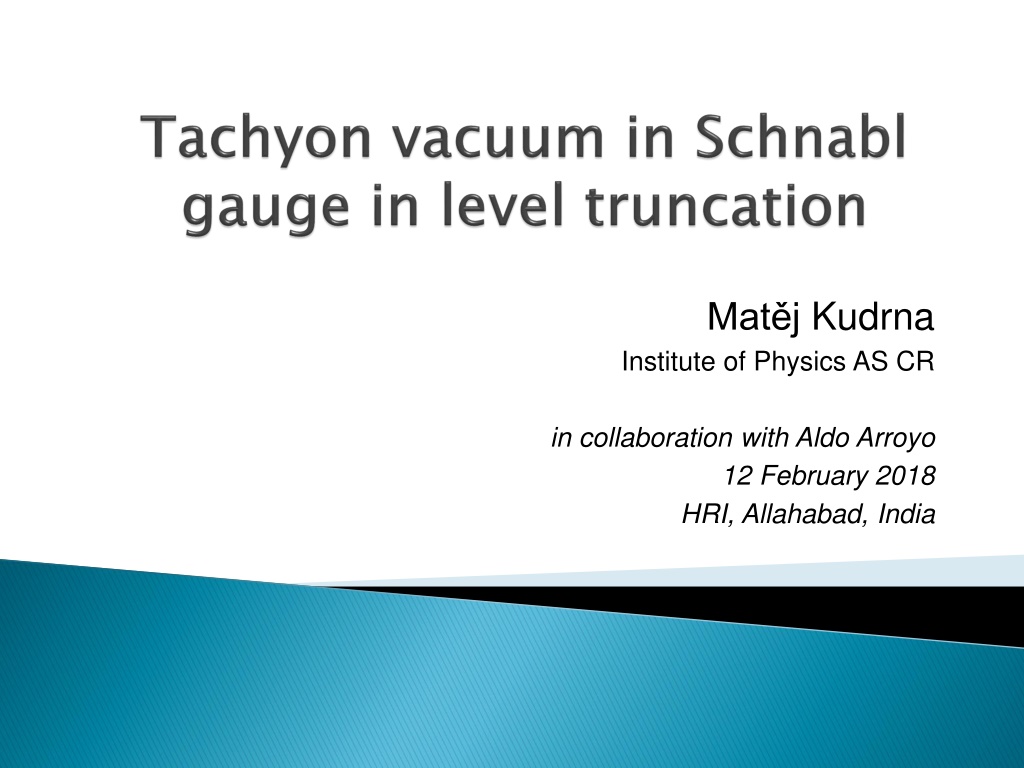
Tachyon Vacuum in Bosonic OSFT
"Explore the tachyon vacuum solution in bosonic open string field theory (OSFT) and its applications in D-brane decay through tachyon condensation. Discover the numerical and analytical solutions, gauge symmetries, and level truncation approaches in the study of string field theory."
Download Presentation

Please find below an Image/Link to download the presentation.
The content on the website is provided AS IS for your information and personal use only. It may not be sold, licensed, or shared on other websites without obtaining consent from the author. If you encounter any issues during the download, it is possible that the publisher has removed the file from their server.
You are allowed to download the files provided on this website for personal or commercial use, subject to the condition that they are used lawfully. All files are the property of their respective owners.
The content on the website is provided AS IS for your information and personal use only. It may not be sold, licensed, or shared on other websites without obtaining consent from the author.
E N D
Presentation Transcript
Matj Kudrna Institute of Physics AS CR in collaboration with Aldo Arroyo 12 February 2018 HRI, Allahabad, India
Tachyon vacuum is the basic solution in bosonic OSFT, which describes D-brane decay through tachyon condensation. As universal solution it can be found on any D-brane system. The first tachyon vacuum solution was found numerically in Siegel gauge. Subsequently several improvements of precision has shown that it satisfies Sen s first conjecture with great precision. The first analytic solution was found by M. Schnabl [hep- th/0511286] and it was followed by several generalizations in terms of KBc algebra.
In this work we attempt to reproduce Schnabls solution in level truncation. These calculations were initiated by A. Arroyo et al. [hep- th/1707.09452]. They evaluated the tachyon vacuum solution to level 10 and made several predictions about its behaviour at higher levels. We will test these predictions and compare the numerical solution both with the analytic and Siegel gauge solution. We can hope to get some information about validity and convergence properties of the level truncation approach in general.
The bosonic OSFT action has well known gauge symmetry We expand the string field in basis of L0eigenstates In this basis the action is given by cubic polynomial in ti Gauge symmetry and L0do not commute the exact symmetry is broken.
It is possible to solve the corresponding equations of motion without any gauge fixing. Due to the broken symmetry we find a discrete set of solutions, but the level truncation scheme becomes unstable the gauge must be fixed. Im[E] 2 1 Re[E] -1 0 2 -1 -2
The most common (and most convenient) gauge is the Siegel gauge The gauge condition is level-independent. It can be easily implemented by removing states with c0from the spectrum or by restriction to SU(1,1) singlet states in the ghost BCFT. The Schnabl gauge condition is given by where It does not commute with L0, which makes it more difficult to implement.
The gauge condition translates to linear constraints on coefficients of the string field. In matrix form we can write them as We have to solve both the equations of motion and the constraints the system of equations becomes overdetermined. It is possible to satisfy only projected set of equations while the rest must be left unsolved.
However physical solutions must satisfy the missing equations in the infinite level limit and therefore we can use them as consistency check. The matrix G has simplest form in basis given by modes of b and c ghosts. Therefore the generic element of our string field will is Other possible bases in ghost sector (in terms of ghost Virasoros or ghost current) would lead to more complicated matrix G.
After some linear algebra and column rearrangement the matrix G can be written as This form allows us to divide the variables into independent and dependent set. The independent variables can be chosen so that they agree with Siegel gauge. Now we have to choose projector on the equations of motion. In principle different choices are possible as long as they give the same number of equations as variables.
For example Kishimoto and Takahashi used Siegel gauge projector in their calculations in a-gauge. The most natural choice comes from substition of the dependent variables into the action Then we obtain the equations of motion by variation of the reduced action Unfortunately this cannot be done explicitly, because we store the cubic vertices only in factorized form
However we can derive formula for projector on the equations of motion We solve the equations iteratively by Newton s method where f(t) are the full equations and M(t) their Jacobian. The Newton s method for the projected equations takes form
For universal solutions we compute only two gauge invariant observables: Energy Ellwood invariant As consistency check we also compute the first omitted equation of motion. Both in Siegel and Schnabl gauge it can be expressed as For tachyon vacuum solution all three quantities should converge to zero.
We use extrapolatrions to estimate behaviour of the solutions at infinite level. We use two different functions: Polynomial in 1/L rational function In most cases both options give similar results. The best results are usually given by extrapolation of maximal possible order. For E0we have to extrapolate levels 4k and 4k+2 separately.
Extrapolations of energy in Schnabl gauge (blue) and Siegel gauge (red) Energy 0.010 0.005 1/L 0.1 0.2 0.3 0.4 0.5 -0.005 -0.010
Extrapolations of Ellwood invariant E0 0 0.10 0.08 0.06 0.04 0.02 1/L 0.1 0.2 0.3 0.4 0.5
At level 30 in Siegel gauge we have confirmed a prediction by Gaiotto and Rastelli that the energy has minimum at level 28. In Schnabl gauge the solution behaves in similar way and overshoots the correct value. A. Arroyo correctly predicted that the energy has minimum is at level 12. The extrapolation overshoots the correct value again low precision or multiple oscillations? Extrapolations work better in Siegel gauge than in Schnabl gauge. The precision is better by one or two orders.
Comparison of selected coefficients of the numerical solution and Schnabl s solution: We find a rough agreement, but the precision is not very good.
Closer look at the tachyon coefficient Obvious difference between extrapolation and analytic value. A. Arroyo predicted minimum at level 26, the minimum probably exists, but at much higher level. Compared to Siegel gauge the extrapolation changes significantly with increasing maximal level. Closer look at the tachyon coefficient t 1/L 0.1 0.2 0.3 0.4 0.5 0.552 0.550 0.548 0.546 0.544 0.542
We can find all possible seeds for Newtons method at low levels using homotopy continuation method. We have found all twist even solutions up to level 6 (approximately 226 6.7 107solutions). Among them there are two stable solutions with energy of order 1. They are quite different from solutions in Siegel gauge. We have also found all non-even solutions up to level 5, but none of them seems to be well-behaved.
Solution number 3 Solution number 3 Somewhat similar behaviour to Double brane in Siegel gauge. Large imaginary part probably not physical.
Solution number 7 Solution number 7 Rare case of real and stable solution. It is plausible that all quantities converge to zero it could be gauge transformation of tachyon vacuum.
We have developed numerical algorithm which allows us to compute solutions in Schnabl gauge (and possibly also in other gauges). We computed tachyon vacuum solution in Schnabl gauge to level 24. We found correct gauge invariants, but also relatively bad agreement with Schnabl s solution. Possible resolutions: The solution has different asymptotic behaviour from Siegel gauge we may need different extrapolation technique.
There is something wrong with the selected equations of motion. We can try to change the projector (for example c0b0 from Siegel gauge) and see whether we obtain better behaviour. Alternatively we can try to find string field that would minimaze violation of the equations instead of solving the projected set. The numerical and analytic solutions differ by gauge transformation.

